Roles of narrow- and broad-spiking dorsal premotor area neurons in reach target selection and movement production
- PMID: 20164405
- PMCID: PMC2853267
- DOI: 10.1152/jn.00238.2009
Roles of narrow- and broad-spiking dorsal premotor area neurons in reach target selection and movement production
Abstract
Most visual scenes are complex and crowded, with several different objects competing for attention and action. Thus a complete understanding of the production of goal-directed actions must incorporate the higher-level process of target selection. To examine the neural substrates of target selection for visually guided reaching, we recorded the activity of isolated neurons in the dorsal premotor area (PMd) of monkeys performing a reaction-time visual search task. In this task, monkeys reached to an odd-colored target presented with three distractors. We found that PMd neurons typically discriminate the target before movement onset, ∼150-200 ms after the appearance of the search array. In one subset of neurons, discrimination occurred at a consistent time after search array onset regardless of when the reaching movement occurred, suggesting that these neurons are involved in target selection. In a second group of neurons, discrimination time depended on reach reaction time, consistent with involvement in movement production but not in target selection. To look for physiological corroboration of these two functionally defined groups, we analyzed the extracellular spike waveforms of recorded neurons. This analysis showed a population of neurons with narrow action potentials that carried signals related to target selection. A second population with broader action potentials was more heterogeneous, with some neurons showing activity related to target selection and others showing only movement production activity. These results suggest that PMd contains signals related to target selection and movement execution and that different signals are carried by distinct neural subpopulations.
Figures
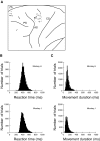

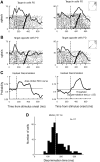
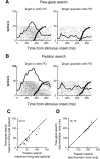
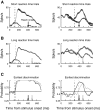

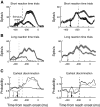

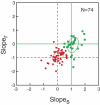

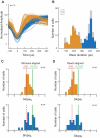
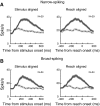
Similar articles
-
Saccade target selection in the superior colliculus during a visual search task.J Neurophysiol. 2002 Oct;88(4):2019-34. doi: 10.1152/jn.2002.88.4.2019. J Neurophysiol. 2002. PMID: 12364525
-
Dorsal premotor cortex: neural correlates of reach target decisions based on a color-location matching rule and conflicting sensory evidence.J Neurophysiol. 2015 Jun 1;113(10):3543-73. doi: 10.1152/jn.00166.2014. Epub 2015 Mar 18. J Neurophysiol. 2015. PMID: 25787952 Free PMC article.
-
A relative position code for saccades in dorsal premotor cortex.J Neurosci. 2010 May 12;30(19):6527-37. doi: 10.1523/JNEUROSCI.1625-09.2010. J Neurosci. 2010. PMID: 20463216 Free PMC article.
-
Laminar differences in decision-related neural activity in dorsal premotor cortex.Nat Commun. 2017 Sep 20;8(1):614. doi: 10.1038/s41467-017-00715-0. Nat Commun. 2017. PMID: 28931803 Free PMC article.
-
Target-, limb-, and context-dependent neural activity in the cingulate and supplementary motor areas of the monkey.Exp Brain Res. 2004 Oct;158(3):278-88. doi: 10.1007/s00221-004-1895-0. Epub 2004 Jul 29. Exp Brain Res. 2004. PMID: 15365665
Cited by
-
Neural correlates of perceptual decision making before, during, and after decision commitment in monkey frontal eye field.Cereb Cortex. 2012 May;22(5):1052-67. doi: 10.1093/cercor/bhr178. Epub 2011 Jul 17. Cereb Cortex. 2012. PMID: 21765183 Free PMC article.
-
Abandoning and modifying one action plan for alternatives.Philos Trans R Soc Lond B Biol Sci. 2017 Apr 19;372(1718):20160195. doi: 10.1098/rstb.2016.0195. Philos Trans R Soc Lond B Biol Sci. 2017. PMID: 28242729 Free PMC article. Review.
-
Neural Representation and Causal Models in Motor Cortex.J Neurosci. 2017 Mar 22;37(12):3413-3424. doi: 10.1523/JNEUROSCI.1000-16.2017. Epub 2017 Feb 20. J Neurosci. 2017. PMID: 28219983 Free PMC article.
-
Evidence of common and separate eye and hand accumulators underlying flexible eye-hand coordination.J Neurophysiol. 2017 Jan 1;117(1):348-364. doi: 10.1152/jn.00688.2016. Epub 2016 Oct 26. J Neurophysiol. 2017. PMID: 27784809 Free PMC article.
-
A mechanism for decision rule discrimination by supplementary eye field neurons.Exp Brain Res. 2015 Feb;233(2):459-76. doi: 10.1007/s00221-014-4127-2. Epub 2014 Nov 5. Exp Brain Res. 2015. PMID: 25370345
References
-
- Akaike H. A new look at the statistical model identification. Automatic control. IEEE Transactions on 19: 716–723, 1974
-
- Bartho P, Hirase H, Monconduit L, Zugaro M, Harris KD, Buzsaki G. Characterization of neocortical principal cells and interneurons by network interactions and extracellular features. J Neurophysiol 92: 600–608, 2004 - PubMed
-
- Batista AP, Santhanam G, Yu BM, Ryu SI, Afshar A, Shenoy KV. Reference frames for reach planning in macaque dorsal premotor cortex. J Neurophysiol 98: 966–983, 2007 - PubMed
Publication types
MeSH terms
Grants and funding
LinkOut - more resources
Full Text Sources

